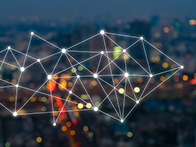If you feel like AI has moved from “bright shiny object” to “how we actually grow,” you’re right. Over the next five years, AI will shape where marketing dollars go, who gets found in search (and AI answers), and which teams capture outsized profit. Here’s a data driven look at what’s coming and how to surf the wave.
The money is pouring in (and accelerating)
Enterprises spent roughly $235B on AI in 2024, and that figure is projected to nearly triple to $630B+ by 2028—an ~30% CAGR. Generative AI is the rocket booster inside that total: it accounts for about 17% of AI spend today, on track to ~32% by 2028 as it grows at a ~60% five year CAGR. (IDC Blog)
Zoom into marketing-specific categories and the pattern holds. The “AI for Sales & Marketing” market is forecast to expand from $58.0B in 2025 to $240.6B by 2030 (a 32.9% CAGR). Meanwhile, “AI in marketing” as a broader segment is modeled to climb from $23.7B (2022) to $94.1B by 2029 (21.8% CAGR), and the generative-AI-in-marketing niche from $2.0B (2022) to $22.0B by 2030 (36.1% CAGR). Different firms, different scopes—same direction: rapid, compounding growth. (MarketsandMarkets)
Ad channels are evolving with it. PwC’s latest media outlook highlights AI powered advertising (especially in digital and connected TV) as a key driver in the industry’s growth through 2029, with digital formats rising toward 80% of ad revenue. That matters for marketers because AI is increasingly embedded in targeting, creative, and media optimization layers. (Reuters)
Why marketing is one of AI’s biggest value pools
McKinsey’s landmark work on generative AI’s economics consistently finds that ~75% of GenAI’s potential value clusters in four functions including marketing & sales. For marketing specifically, they estimate productivity gains worth 5–15% of total marketing spend—roughly $463B annually at global scale. That’s not a niche efficiency play; it’s a structural margin lever. (McKinsey & Company)
Adoption is catching up to the promise. As of 2025, 78% of companies report using AI in at least one business function, with marketing & sales among the most active users; regular GenAI use has surged as well. Expect the next five years to shift from pilots to scaled workflows across content ops, audience modeling, creative testing, SEO, and LLM visibility. (McKinsey & Company)
Profit share: the early majority will see AI show up in P&L
A practical way to think about “profit share” is the portion of operating profit (EBIT) that leaders can directly attribute to AI. McKinsey’s surveys identify a cohort of “AI high performers” who already attribute ≥20% of EBIT to AI proof that AI is not just a cost line; it’s a profit engine when embedded in core go-to-market. In 2024 data, 42% of high performers said >20% of EBIT came from (non-gen) analytical AI alone; many also report double digit contributions from GenAI. Over the next five years, expect that ≥10–20% AI-attributable EBIT band to become the norm among scaled adopters in marketing intensive sectors. (McKinsey & Company)
Real companies are already booking savings and reallocation. Klarna publicly quantified ~$10M in annual marketing cost reductions from GenAI creative and tooling while increasing output illustrating how AI can improve both the numerator (revenue) and denominator (cost) of marketing ROI. (Reuters)
Caveat: returns are uneven. A recent MIT covered study finds many GenAI pilots stall without integration to real workflows so value accrues to teams that operationalize, not just experiment. (Tom’s Hardware)
What AI growth specifically changes in internet marketing
1) Search is no longer just Google. AI assistants (ChatGPT, Gemini, Perplexity, Copilot) surface brands from machine sources as well as the web index. Over the next five years, LLMs will intermediate more discovery moments. Marketers who publish answer ready facts (services, pricing notes, locations, policies) in llms.txt, plain text “source” pages, and robust schema.org will be cited more often winning assistant visibility in addition to classic SEO. (This is where that 5–15% marketing-productivity upside hiding in “content ops” gets unlocked.) (McKinsey & Company)
2) Creative volume and testing explode. With GenAI assisting copy, imagery, and video variants, teams can 10× experiments without 10× headcount. Expect creative fatigue to fall and match type/format mix to adapt faster as models learn what converts by audience micro segment, channel, and context. The CTV and social video ecosystems already tilting AI-first will reward fast learners. (Reuters)
3) First party data becomes fuel. As cookies fade and walled gardens thicken, modeling on your own CRM/CDP data improves look alike quality, LTV predictions, and offer timing. AI spend will show up not only in martech line items but also in data engineering and governance that raise model quality. (IDC’s spending mix shift toward GenAI by 2028 aligns with this retooling.) (IDC Blog)
4) Security shifts from “IT thing” to “growth thing.” If your WordPress stack gets popped, your AI indexed facts go stale or worse, misinform customers. The next five years will see security posture and AI visibility tightly coupled: secure sites get crawled reliably; insecure ones struggle with downtime, spam content, and trust signals.
A five year roadmap (what to implement now)
Year 1: foundation
- Publish llms.txt and plain text source pages (FAQ + Services index).
- Fix schema.org (Organization, Service, FAQ), XML sitemaps, robots, caching.
- Stand up creative ops with GenAI for headlines, CTAs, and image variants; pair with human QA.
- Institute WordPress hardening (2FA, least-privilege, WAF, backups, integrity scans).
Years 2–3: compounding
- Train audience and LTV models on first-party data; feed insights into lifecycle flows (email/SMS/retargeting).
- Scale programmatic content for services/cities with strict editorial guardrails.
- Expand to CTV and retail media as AI creative/testing improves unit economics.
Years 4–5: profit share at scale
- Tie AI programs to contribution margin and incremental ROAS; phase out low-yield spend.
- Introduce agentic workflows (e.g., lead triage, product updates) with clear human-in-the-loop checkpoints.
- Aim for double digit EBIT contribution from AI by embedding it in planning, budgeting, and ops not running it as a side project. (McKinsey & Company)
What the numbers imply for budgets
If your marketing budget is $1M, McKinsey’s 5–15% productivity band suggests $50k–$150k of “found” value per year as GenAI gets embedded value you can redeploy to growth. Across the industry, that’s the $463B annual productivity prize McKinsey points to. Since AI spend is set to triple by 2028, most teams will be approving bigger AI lines but the winners will be the ones who can show that a rising AI share of spend maps to a rising share of profit (EBIT). (McKinsey & Company)
Bottom line
The next five years won’t be about tinkering; they’ll be about operationalizing AI across the internet marketing stack. Budgets are moving, platforms are adapting, and the profit share of teams that scale AI (and measure it) will widen. Get your facts machine-parsable, your content engine test ready, your data pipelines clean, and your site locked down. The growth curve is here; it’s time to climb it.
Sources
- IDC: global AI spending to $632B by 2028; GenAI’s rising share and growth rates. (IDC)
- MarketsandMarkets / Grand View / Stratview: AI in marketing and GenAI-in-marketing market size & CAGR forecasts to 2029–2030. (MarketsandMarkets)
- McKinsey: 5–15% marketing productivity prize (≈$463B/yr); 75% of GenAI value concentrated in functions including marketing & sales; adoption & EBIT contribution data. (McKinsey & Company)
- PwC (via Reuters): AI-powered advertising propelling digital/CTV share through 2029. (Reuters)
- Reuters (Klarna): $10M annual marketing cost savings from GenAI creative. (Reuters)
- MIT covered study: many GenAI pilots miss P&L impact without deep workflow integration (execution matters). (Tom’s Hardware)









